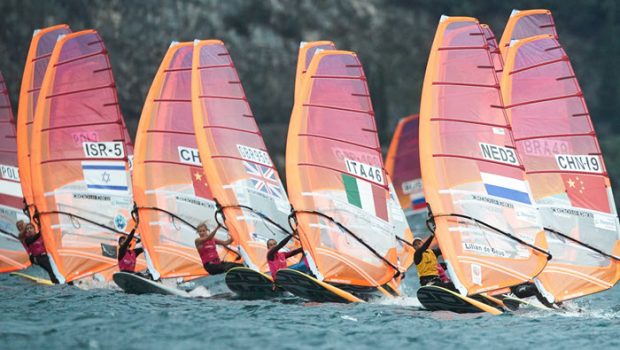RS:X Class pivots to secure future
Published on June 22nd, 2020
The Olympic Sailing Program has a long history of evolution, making adjustments to the event types to reflect the demands of the day. Since 1984, windsurfing has been among the event types, though the equipment selected has changed as windsurfing evolved and the equipment developed.
It began with the Windglider Class but was changed to the Lechner Division 2 board for 1988 and 1992 while the Mistral Class was used in 1996, 2000, and 2004. With the sentiment for change again, and with an agreement on certain parameters, the all-new RS:X developed by Neil Pryde was selected for 2008.
This was following a new era for Olympic equipment, beginning with the 49er skiff for Sydney 2000, wherein new equipment was created based on requirements, with the development and manufacturing held privately rather than open such as was the case for the 470 or Finn.
If you wanted an RS:X, it came from Neil Pryde, with the equipment to be used for its fourth games at Tokyo 2020.
But when the International Olympic Committee issued its Olympic Agenda 2020 in 2014, it put all Olympic sailing events and equipment on notice. The IOC was evolving, and the competitions had to too. Staging events with appeal to young sailing and non-sailing fans, which delivered universality and gender equity, was now the mandate.
When World Sailing voted for continuity from Rio 2016 for Tokyo 2020, the IOC was not impressed, so it was for Paris 2024 that change was needed, and when the smoke cleared, the Sailing Program was significantly altered, with the equipment for the Windsurfing event changed from the RS:X to the iQFoil.
Mr. Neil Pryde, who had relinquished control of his company in 2015, was not impressed, issuing this statement to outline why the RS:X Class was the most suitable Olympic equipment. As for those controlling the company, they told World Sailing they would not be providing the equipment for Tokyo 2020 as had been anticipated.
Losing status as Olympic equipment, the question now became whether there was sufficient interest in the RS:X Class for it to survive. Did people participate in RS:X events because they loved the organization, equipment, and people, or was it the Olympic aura that was the attraction?
While time will be the decider, here’s a statement from the International RS:X Class Association on how they are managing the road forward:
During the worldwide COVID-19 lockdown, the RS:X Class Association has continued to work in the background in supporting its sailors and MNAs (Member National Authorities) with a range of issues and concerns.
The primary concern raised has been about the supply of equipment for those sailors looking to Tokyo 2020 (to be held on 2021) who will need to train on fresh equipment as well as continuing their equipment selection processes.
Alongside this, NeilPryde Ltd. who have been overseen the production of the RS:X for 4 Olympic cycles, has been looking to move away from the single manufacturer option to a more open market for manufacturers. This reflects the anti-trust concerns that have dominated discussions at World Sailing over the past two years.
As such NeilPryde feel that now is the right time to transfer the IP of the RS:X to the Class Association and allow a process for multiple manufacturers to exist, appointed by the Class, provided that the consistency, quality, and supply is maintained.
This transfer of IP gives the Class and its sailors control over who is building their equipment. Whatever the future holds for the Class, this set up will be able to adapt to changing circumstances.
Under the arrangement, manufacturing will continue at the existing suppliers of boards, masts, sails, and booms. The appointed manufacturers will now supply product directly to distributors, at the same time as becoming directly accountable for product quality.
NeilPryde Ltd. will remain a part of this manufacturing group, responsible for the production of the sails in its China factory, where it specializes in the high quality, tightly consistent production of sails for other Olympic and Youth One Design Classes.
Athletes will be able to continue to buy equipment from their local distributor, and will benefit from an 8% average drop in the retail prices.
The RS:X Class have also been looking at the next 12 months and beyond as the postponement of the Tokyo Olympic Games also offers up some different opportunities. The Class is keeping a close eye on its events in line with the whole sailing calendar to ensure that when events start to happen again, the overlap is reduced to ensure that conflicts are minimalized.
As more RS:X sailors start to receive their iQFoil equipment, making sure that RS:X events represent value for money is important to the Class.
The RS:X Class have also been invited to put forward an equipment bid by World Sailing for the 2022 Youth Olympic Games, due to be held in Senegal. The Class are considering this alongside the wider windsurfing community to ensure the best equipment for the sport as a whole is put forward.
Tokyo Olympic Sailing Program
Men’s One Person Dinghy – Laser
Women’s One Person Dinghy – Laser Radial
Men’s Two Person Dinghy – 470
Women’s Two Person Dinghy – 470
Men’s Skiff – 49er
Women’s Skiff – 49erFx
Men’s One Person Dinghy Heavy – Finn
Men’s Windsurfing – RS:X
Women’s Windsurfing – RS:X
Mixed Multihull – Nacra 17
Original dates: July 24 to August 9, 2020
Revised dates: July 23 to August 8, 2021









 We’ll keep your information safe.
We’ll keep your information safe.